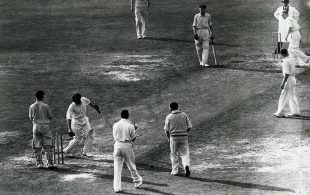God's own blob
The story of the most famous duck in the game
Brydon Coverdale
16-Aug-2008

| ||
It remains one of cricket's great ironies that Don Bradman's most universally remembered innings is one in which he utterly failed. His 0 at The Oval in 1948 is without question the most famous duck in the game's history. Every cricket fan knows the significance of Bradman's nought: it was his final Test innings and he needed four runs to finish with a career average of 100. But the facts of the incident sometimes get forgotten amid the legend.
The day was August 14, 1948. It was the tail end of a remarkable tour by an unbeaten Australia squad that would later become known simply as the Invincibles. They entered the fifth and final Test on the back of one of the greatest victories in history. Their fifth-day chase in the fourth match at Headingley, when they finished with 404 for 3, was at the time the highest successful fourth-innings chase in Tests, and it remains third on the all-time list. When the winning runs were struck, Bradman was at the non-striker's end on 173.
It was one of two Test centuries Bradman achieved in the series, and one of his 11 first-class hundreds on the trip. He was on his fourth tour of England, where he had managed 11 memorable Test centuries. By the time The Oval match came around, Bradman was a fortnight shy of his 40th birthday and there was no doubt it would be his final Test. The fans were eagerly anticipating a farewell display of his familiar brilliance.
The start of the game was delayed as the ground was saturated by heavy rain earlier in the week. When Norman Yardley won the toss and decided to bat on Saturday, the fans who had turned out must have assumed Bradman would not be seen at the crease until at least the Monday. But a disastrous batting effort from England, who collapsed for 52, with only Len Hutton reaching double-figures, meant that Australia were batting less than three hours after the match began.
Even then it wasn't clear if Bradman would be sighted before stumps, as Australia's openers Arthur Morris and Sid Barnes cantered past England's total with ease. It was nearly 6pm when Barnes was caught behind off the bowling of the legspinner Eric Hollies. Morris expected a night-watchman to join him at the crease. Instead, out came Bradman.
| The next was a googly and in a rare moment of sub-genius, Bradman failed to pick it. The ball darted in through the gap as Bradman lunged forward, caught his inside edge and struck off stump. He thrust the bat under his arm, looked reflectively to the heavens and walked off | |||
The man who had enthralled spectators and frustrated opponents in equal measure was welcomed with a standing ovation from the crowd. Yardley shook hands with Bradman and led his England men in three cheers, their actions echoed by the fans all around The Oval. Even in a sport that viewed itself as the gentleman's game it was an extraordinary gesture, and one that reminded Bradman of a similar farewell given to Jack Hobbs on the same ground 18 years earlier.
"That reception had stirred my emotions very deeply and made me anxious - a dangerous state of mind for any batsman to be in," Bradman later wrote in Farewell to Cricket. "I played the first ball from Hollies, though not sure I really saw it."
It was a legbreak; the next was a googly and in a rare moment of sub-genius, Bradman failed to pick it. The ball darted in through the gap as Bradman lunged forward, caught his inside edge, and struck off stump. He thrust the bat under his arm, looked reflectively to the heavens and walked off. The crowd, stunned into silence by the unexpected duck, quickly snapped out of it and ensured Bradman left Test cricket with another standing ovation. Just before he entered the dressing room he said to Keith Miller: "Fancy doing a thing like that!"
Hollies later said that he thought Bradman had tears in his eyes and didn't see the ball properly. Bradman was emotional but he flatly refuted that claim. "I knew it would be my last Test match after a career spanning 20 years," Bradman later said. "But to suggest I got out, as some people did, because I had tears in my eyes while I was looking at the bowler was quite untrue. Eric Hollies deceived me and he deserves full credit."
Bradman did not know at the time that he needed four runs to finish with a career Test average of 100. Neither did he know that he would never again bat in a Test. "Don't forget that at the moment I got out there was no way of knowing it would be my last Test innings," he said, "because at that point in time I might have been able to bat again in Australia's second innings."
Realistically, that was wishful thinking. Australia already led by 65 runs on the first innings with eight wickets in hand. They ended up winning by an innings and 149 runs. It's impossible to know if the innings would have been remembered so vividly had Bradman made 4 or 20 or 100. Instead, a man who was seen by some as a cricketing god was shown to be human after all, perhaps only increasing the recognition for his earlier achievements. He had to settle for a career average of 99.94. It was to become the most famous number in Australian cricket.
Bibliography
Farewell to Cricket by Don Bradman, Hodder and Stoughton, 1950
The Bradman Digital Library
Wisden Almanack 1949
Farewell to Cricket by Don Bradman, Hodder and Stoughton, 1950
The Bradman Digital Library
Wisden Almanack 1949
Brydon Coverdale is a staff writer at Cricinfo